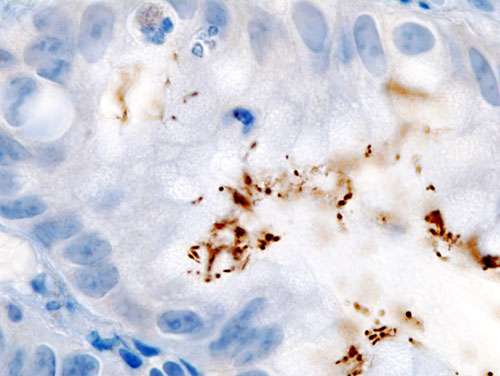Revealed: Helicobacter pylori's secret weapon

Discovered in 1982, Helicobacter pylori (H. pylori) is a disease-causing bacterium that survives in our stomachs despite the harsh acidic conditions. It is estimated that one in two people have got it, though most won't ever experience any problems. Even so, it is considered one of the most common bacterial infections worldwide and a leading cause of dyspepsia, peptic ulceration and gastric cancer.
Through unique evolutionary adaptations, H. pylori is able to evade the antiseptic effect of our stomach acid by hiding within the thick acid-resistant layer of mucus that coats the stomach wall. Once within the mucus layer, the bacterium latches onto sugars naturally found on the stomach wall using its adhesion proteins. This attachment is so effective that the bacterium can resist attempts by the body to 'flush' it away, allowing the pathogen to colonise with impunity.
But the game could be up for H. pylori. Researchers in the School of Pharmacy, at The University of Nottingham and AstraZeneca R&D have identified the molecular mechanism that the bacterium's best-known adhesion protein uses to attach to stomach sugars. The research is published today, August 14 2015, in the prestigious scientific journal Science Advances.
Powerful x-rays reveal special 'groove'
Finding the molecular interactions that make this pathogen so successful in such a harsh environment has, until now, proved elusive.
Naim Hage, the postgraduate researcher who worked on this project as part of his doctoral thesis, said: "Although it's still very early, the insight we've gained from this study is already very exciting news for patients."
Using extremely powerful x-rays, the scientists were able to study the interactions between the H. pylori adhesion protein BabA and Lewisb sugars of the gastric mucosa at the atomic level. They found that, right at its tip, BabA possesses a specific groove that enables it to securely attach to Lewisb using a network of hydrogen bonds (the same kind of interactions that keep water molecules together).
First exciting step
The research team also found that this network is finely tuned - if a few of the hydrogen bonds are disrupted, the network doesn't function and binding can no longer occur. This insight into the molecular interactions required for adhesion is a promising lead for the development of new strategies for the treatment of H. pylori infections.
This study now forms the foundation for future research between The University of Nottingham and AstraZeneca R&D into "anti-adhesion strategies" that would work by clearing H. pylori out of the stomach through dislodging the bacterium off the stomach wall using BabA:Lewisb inhibitors. Such novel strategies are needed to help treat H. pylori infections, which are globally gaining resistance to conventional antibiotic therapies.
Naim said: "Because BabA is unique to H. pylori, we can specifically target, and hopefully eradicate, this bacterium without affecting the other good bacteria in our normal flora. If successful, this therapeutic strategy will also be extremely useful for treating H. pylori infections that are already resistant to antibiotics."
More research to be done
The principal investigator behind the project, Dr Franco Falcone, said: "While this study answers long-standing questions about how H. pylori colonises the stomach, it represents the very first step in the development of novel therapies. The next few years of laboratory-based research will be crucial to determine if an anti-BabA adhesion approach is viable and can progress to clinical development. A similar approach is already showing promising results for the treatment of urinary tract infections in preclinical models. Looking forward, we are excited to continue working closely with AstraZeneca R&D who have provided a tremendous amount of support to achieve this discovery."
More information: Structural basis of Lewisb antigen binding by the Helicobacter pylori adhesin BabA, Science Advances, advances.sciencemag.org/content/1/7/e1500315
Journal information: Science Advances
Provided by University of Nottingham



















